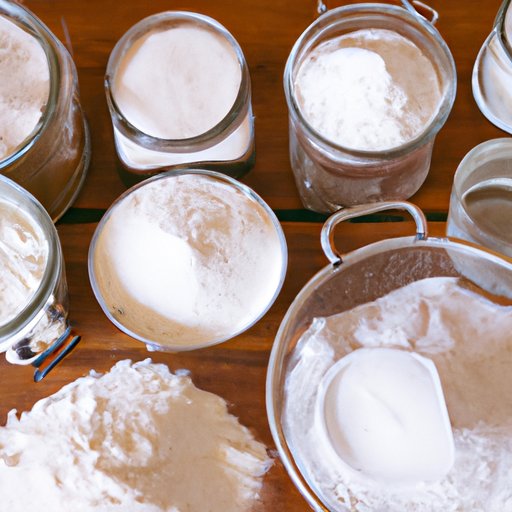
Introduction
Flour is one of the most essential ingredients in cooking and baking. Whether you’re making bread, cakes, or pastries, good quality flour is crucial for achieving the best results. While there are numerous options for purchasing flour at the store, making it at home can be a fun and rewarding experience. In this article, we will provide you with a comprehensive guide to making flour at home, breaking down the steps, techniques, and benefits of DIY flour-making.
Aside from being a fun experience, making flour at home comes with many other perks. You get to control the quality of the flour, which is essential for a healthier and more nutritious diet. Additionally, homemade flour contains no additives, preservatives, or chemicals, making it a safer and healthier option for you and your loved ones.
A Beginner’s Guide to Making Homemade Flour: Tips and Techniques
If you’re new to making flour at home, it’s important to begin by considering a few key factors that will affect the final product. The first step is to choose the right grain. Grains like wheat, barley, oats, and rice are popular choices for making flour. It’s important to select grains that are fresh, clean, and not damaged.
The equipment needed for making flour varies, depending on the grain you’re using and the type of flour you want to make. However, there are two main types of equipment that you’ll need: a mill and a sifter. A mill grinds the grain into flour, while a sifter separates the flour from any remaining bran and germ, resulting in a finer texture.
From Wheat to Flour: A Step-by-Step Tutorial
Wheat is one of the most popular grains used for making flour. There are several types of wheat, including hard white, soft white, hard red, and soft red. Hard wheat varieties are preferred for making bread, while soft wheat varieties are used for making pastries and cakes.
Begin the process of making flour by washing the wheat berries to remove any dirt or debris. Once cleaned, the wheat can be soaked or sprouted, which makes it easier to digest. After soaking, dry the wheat berries and use a mill to grind them into flour.
You can also sift the flour to create a finer texture and remove any bran or germ. Sifted flour is best used for pastries and cakes, while unsifted flour can be used for bread and other baked goods.
Gluten-Free Flour Making: Easy Recipes for Home
If you’re looking for an alternative to traditional wheat-based flour, there are numerous gluten-free flours available. Gluten-free flour is ideal for people with celiac disease or anyone looking to reduce their gluten intake.
Common types of gluten-free flours include almond, coconut, chickpea, rice, and buckwheat flour. Once again, it’s important to choose fresh, high-quality grains for making flour. You can use a food processor or blender to grind the grains into a fine powder.
When making gluten-free flour, it’s important to use a combination of flours to achieve the desired texture and taste. You can experiment with different types of flours and combinations until you find the perfect match for your needs.
Grind Your Way to Health: Nutritious Flour-Making Methods
Making flour at home allows you to preserve the nutritious value of the grains, making it a healthier option for you and your family. Whole grains are packed with nutrients, including fiber, protein, and vitamins, making homemade flour an ideal choice for maximizing your nutritional intake.
You can choose from a variety of grains like quinoa, amaranth, teff, and millet to make flour. These grains are naturally gluten-free and have a high nutritional content. Using a mill to grind the grains into fine powder helps to retain their nutrients and flavor.
The Art of Flour Making: Traditional and Innovative Methods
While traditional flour-making methods involve grinding grains using a millstone, there are numerous innovative methods available for making flour. For example, you can use a food processor or blender to grind grains into a fine powder quickly.
You can also use traditional methods like pounding grains in a mortar and pestle or using a hand-cranked mill. These methods are more time-consuming but can be therapeutic and enjoyable. Experimenting with different methods can help you find the one that works best for you.
Sustainable Living: Making Flour from Alternative Grains
Using alternative grains is becoming increasingly popular for making flour because they are more sustainable and environmentally friendly. These grains require less water and can grow in harsher conditions, making them easier to cultivate.
Some common alternative grains used for making flour include spelt, kamut, einkorn, and emmer. These ancient grains have a unique flavor and texture and are becoming popular in artisanal baking. Use a mill to grind the grains into flour, and sift to remove any bran and germ.
DIY Flour: How to Control Quality and Save Money at Home
Making flour at home can save you a significant amount of money in the long run. Instead of purchasing expensive artisanal flours or gluten-free flours, you can make it yourself at a fraction of the cost. Additionally, making flour at home allows you to control the quality of the flour, ensuring that it is fresh, nutritious, and free from additives.
You can store homemade flour in an airtight container in a cool, dry place for up to six months. If you don’t plan on using the flour right away, store it in the freezer for an even longer shelf life.
Conclusion
Making flour at home is a fun and rewarding experience that comes with numerous benefits. You can control the quality of the flour, ensure that it is fresh and nutritious, and experiment with new flavors and textures. By following the tips, techniques, and tutorials provided in this comprehensive guide to making flour at home, you’ll be well on your way to enjoying delicious, healthy homemade flour in no time.




